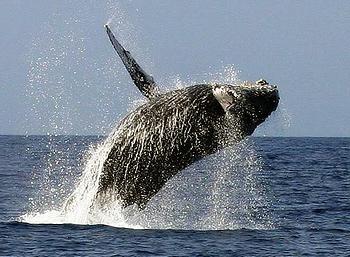
WASHINGTON, DC, December 6, 2019 (ENS) – A fresh perspective on the world’s whale population could be “earth-changing,” writes the World Economic Forum’s Katharine Rooney in a new article on how whales can help reverse climate change.
Rooney explores the findings of the International Monetary Fund, IMF, which has just estimated the monetary value of a single great whale at more than US$2 million, totaling more than $1 trillion for the current numbers of great whales in all the world’s oceans.

The IMF based its figures on each whale’s contribution to carbon capture, the fishing industry and the whale-watching sector, which alone is worth over $2 billion.
If humans helped whales return to their pre-whaling numbers of four to five million – up from 1.3 million today, researchers say they could capture 1.7 billion tonnes of CO2 annually – with the cost of protecting them at just US$13 per person a year.
Over a lifespan of around 60 years, whales – especially great whales, such as right whales and grey whales – accumulate an average of 33 tonnes of the greenhouse gas carbon dioxide (CO2). When they die, they sink to the bottom of the ocean, sequestering that carbon away for hundreds of years.
By comparison, a tree absorbs up to 48 pounds of CO2 a year.
Part of the carbon capture potential of whales comes down to their role in increasing phytoplankton productivity wherever they go – a phenomenon called the “whale pump.”
As whales rise up through the ocean to breathe and migrate across the globe, the iron and nitrogen in their waste provide ideal growing conditions for the microscopic single-celled plants known as phytoplankton.
Like land plants, phytoplankton have chlorophyll to capture sunlight, and they use photosynthesis to turn it into chemical energy. They consume carbon dioxide and release oxygen.
These single-celled plants contribute at least half of all oxygen and capture an estimated 37 billion tonnes, about 40 percent, of all CO2 produced.
The IMF calculates that’s the same as the amount of CO2 captured by 1.7 trillion trees, or four Amazon rainforests’ worth.
A one percent increase in phytoplankton productivity linked to whale activity could mean the capture of hundreds of millions of tons of additional CO2 a year, equivalent to two billion mature trees, the IMF projects.
But the world’s whales are at risk – impacting their ability to help reverse climate change.

Although commercial whaling has been officially banned since 1986, more than 1,000 whales a year are still killed for commercial purposes, according to the World Wildlife Fund, WWF.
Whales are also at risk from ship strikes, entanglement in fishing nets, waterborne plastic waste, and noise pollution.
At the same time, the concentration of CO2 in the atmosphere is increasing rapidly. In May 2019, the levels of CO2 passed 415 parts per million – the highest level in human history.
The ocean helps to regulate the climate by holding 50 times more CO2 than the atmosphere, according to the International Atomic Energy Agency, IAEA. But even a small change in the way carbon enters the ocean could affect the ocean’s storage capacity.
Rooney writes that a recognition of the contribution whales make to carbon capture could be a valuable alternative to costly and untested proposed technological solutions, such as capturing carbon directly from the air and burying it underground.
Many proposed solutions to global warming, such as capturing carbon directly from the air and burying it deep in the earth, or sucking it out of the atmosphere with giant fans are complex, untested, and expensive.
But the simple and essentially “no-tech” strategy of capturing more carbon from the atmosphere by increasing global whale populations is effective and economical, and also has a successful funding model, writes Ralph Chami, an assistant director of the IMF’s Institute for Capacity Development, and colleagues, in the December issue of the IMF journal “Finance and Development.”
“At a minimum, even a 1 percent increase in phytoplankton productivity thanks to whale activity would capture hundreds of millions of tons of additional CO2 a year, equivalent to the sudden appearance of 2 billion mature trees. Imagine the impact over the average lifespan of a whale, more than 60 years,” writes Chami.
“Enhancing protection of whales from human-made dangers would deliver benefits to ourselves, the planet, and of course, the whales themselves. This “earth-tech” approach to carbon sequestration also avoids the risk of unanticipated harm from suggested untested high-tech fixes,” writes Chami. “Nature has had millions of years to perfect her whale-based carbon sink technology. All we need to do is let the whales live.”
<align=”center”>Copyright Environment News Service (ENS) 2019. All rights reserved.
© 2019, Environment News Service. All rights reserved. Content may be quoted only with proper attribution and a direct link to the original article. Full reproduction is prohibited.
